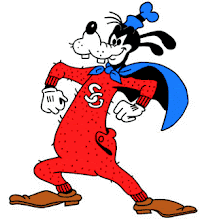
Y'know what I really love to do when I'm terribly depressed and blue? It involves comics...and, well....I'm an odd guy.
One thing I love to do, and trust me, it's hilarious even if it might be considered blasphemous, is go to my local comic shop and pull out four or five issues of
The Incredible Hulk, circa 1970s, out of their quarter boxes (because condition doesn't really matter), read 'em...and while reading them, take an ink pen and magic marker and replace the word "
Hulk" with "Jesus" wherever it might appear, and draw a little beard on the Hulk. Then, go back and read it again.
This exercise is priceless, I assure you. Try it sometime.
The other is go to whatever public retail venue that might be near that sells comic books that
isn't a comic shop (the grocery store, Wal-Mart, gas station) and buy an Archie comic book. This is actually quite a chore, because if you haven't noticed, comics have lost their foothold on the American newsstand, and Archie Comics is one of the few left that's actually stuck it out and is still hanging in there.
Now, I do this because Archie Andrews and his world of Riverdale is comfort food for the fanboy. Over the last nearly 70 years of publication, Archie and the gang have stayed stagnant. Nothing really changes for them except clothing styles and slang. No matter how hectic your life has become, or what troubles you may be facing, the Riverdale kids and their supporting cast remain the same. Sure, within the last few years, Archie Comics has begun experimenting with concepts that seem completely foreign to them, yet common place with all other publishers...i.e., continuing storylines, cross-overs, and the occasional change of pace from the Archie "house" art style....an art style that was pretty much defined by one man in the late 1960s: the late
Dan DeCarlo...but pretty much things are how they've always been in Riverdale. And, I find that comforting and endearing...it's nice to go someplace where (much like the fictional bar "Cheers") everybody does know your name...and they're happy to see you again...just like the last time you were around. It's the comic book fan's equivalent to going back home again...
So, to celebrate the works of DeCarlo, I figured I'd dig deep and drag out some really obscure stuff...

Homer the Happy Ghost, as you can probably already tell, was Atlas/Timely/Marvel's none-to-subtly veiled rip-off of the incredibly successful Harvey Comics "Casper the Friendly Ghost" property, which was written by Stan Lee and illustrated by DeCarlo in the 1950s. In 1970, Marvel decided to revive the series, which was basically reprints of the 50s material that lasted around 5 issues...
From Wikipedia:
Homer the Happy Ghost was published by Atlas Comics in the 1950s. His first issue was dated March 1955. All of the issues were written by Stan Lee and Dan DeCarlo. The title lasted until 1958. 
Willie Lumpkin, has a much more amazing tale, as told again by Wikipedia:
The character was originally created for a syndicated, daily comic strip by writer Stan Lee and artist Dan DeCarlo. Lee had initially submitted samples of a strip about a New York City beat cop, but was told by his editor that it was too "big city-ish" and that he wanted a friendly mailman to better appeal to mainstream America. Willie Lumpkin, which was only published in 1960, drew humor from the people and situations Willie Lumpkin would encounter along his mail delivery route in the small town of "Glenville."
Lee and artist Jack Kirby then introduced their comic book version of Willie Lumpkin in Fantastic Four #11 (February, 1963). The comic book Lumpkin is depicted as significantly older than in the comic strip, though the character's good nature was retained, as were references to his past as a mailman in Glenville, which the comic book located in Nebraska.
In his first comic book appearance, Lumpkin is represented as having befriended the Fantastic Four, to whom he makes regular fan mail deliveries at their Baxter Building headquarters in New York City. He half-jokingly requests to join the team on the grounds that he has the "power" to wiggle his ears. He serves as their mailman for many years, and on occasion falls into the zone of danger that typically surrounds the adventuring heroes. Examples include a story in which he is forced to spend Christmas Eve locked in a closet while the Fantastic Four fight the Super-Skrull, when he helped to save the team from the Mad Thinker, or when he is mind-controlled into accessing Doctor Doom's time machine by a minion of Immortus. An alien Skrull also impersonates him in another story to infiltrate the Fantastic Four's headquarters. Willie Lumpkin also crossed over into Spider-Man comics, where he briefly dates Spider-Man's Aunt May.
Willie Lumpkin appeared in his own solo feature in Marvel Comics Presents #18 (May, 1989). The fan-favorite story was a parody of A Christmas Carol in which Lumpkin is visited by the Ghost of Christmas Past, who had intended to haunt cantankerous Spider-Man nemesis J. Jonah Jameson but couldn't find his address. The story concludes with the normally amiable postman deciding that he hates Christmas.
Willie has since retired, and his niece Billie has taken his position as the Fantastic Four's mail carrier.
Above: Willy's niece- Wilhemina "Billie" Lumpkin
Willie appears in Fantastic Four #543, being interviewed about the FF on the news show 'Lateline'. He talks about how, though the group took on cosmic menaces, they always found time to greet him.

In a lovely little bit of comic book geek fan service, none other than Lumpkin co-creator, Stan Lee, portrayed the mightiest mail carrier of the Marvel Universe in the 2005 Fantastic Four film...
Download Links:Homer the Happy Ghost #1 (1970) CBR file Willy Lumpkin CBR file..


 Above: Hellcow bio (click to enlarge)
Above: Hellcow bio (click to enlarge)














